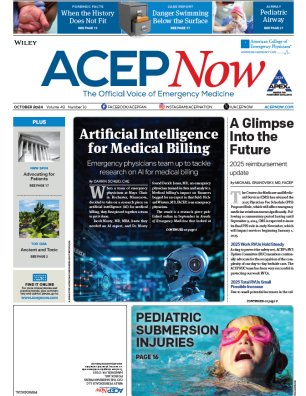A year ago I published my first article in ACEP News. Titled, “Change From Below,” the article was written to encourage providers of all levels, from medical students to attendings, to be open to embracing evidence-based practice, even if new ideas ever-so occasionally came from the lower ranks.
Explore This Issue
ACEP News: Vol 32 – No 04 – April 2013The issue arrived in the mail the very day I graduated from medical school. I was flying high.
A few months later when I actually began residency, I was in for a bumpy landing. I quickly discovered that it was one thing to talk the talk as a medical student with absolutely no responsibility. It was quite another to try to make medical decisions that were progressive, evidence-based, and patient centered but that deviate from some traditional practices.
For one thing, sometimes patients expected antibiotics for things like otitis media and felt like I was giving them the short shrift by not pulling out the prescription pad. That I expected. What surprised me was that I had to confront my own demons. Was I really comfortable practicing in this way? Fortunately, I had supervisors who were the ideal combination of progressive and prudent. I would get my chance.
The very concept I wrote about 1 year ago (the HiNTS exam for distinguishing central versus peripheral causes of vertigo) provided me one of my earliest opportunities to shine as an evidence-based medicine practitioner. After performing my detailed neurology exam, I was ready to discharge a patient who might have otherwise gotten an MRI to rule out a cerebellar vascular accident after presenting with vertigo. I was quite proud of myself.
My attending was supportive of my plan, but given the stakes, he understandably wanted to make sure I knew what I was doing. So he proposed a deal with me. If a neurology consult agreed with my plan, we could skip the MRI. The neurology consultant examined the patient and agreed with my assessment. They even thanked me for doing such a thorough neurological examination.
Again, I was riding high.
‘Now, when I make evidence-based decisions to avoid defensive medicine, a key part of my plan is to actively follow up with the patient within a couple of days by phone.’
But once again, I was in for a rough landing. That night I could not sleep. The next night I had trouble too. What had I done? Had I sent home a patient with a central cause of vertigo? Had I been inappropriately confident? I sat at home with my face buried in my palm, mildly diaphoretic and questioning everything I had done.
Pages: 1 2 3 | Single Page





No Responses to “Change from below: An update from the mid-level”